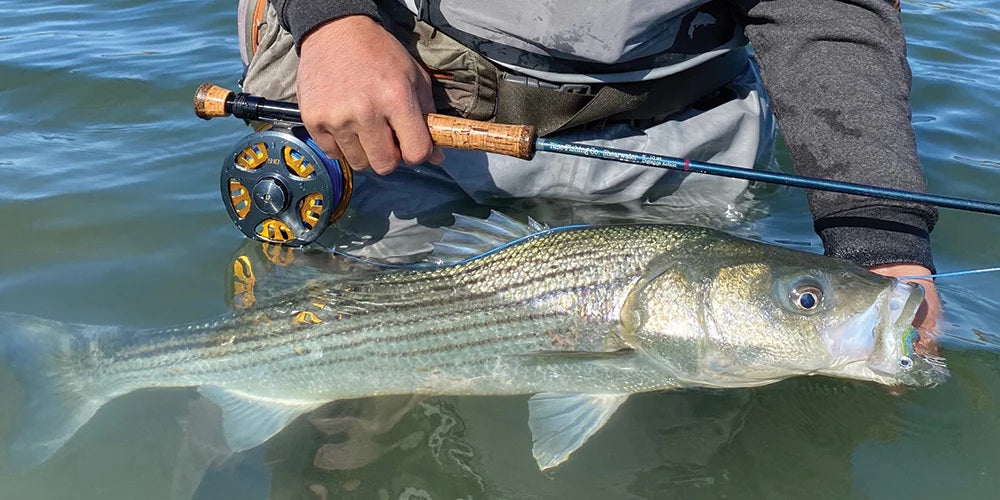
Lamson Fly Reels: An Angler's Guide
Share
Lamson reels sit in that sweet spot where classic fly-reel aesthetics meet modern engineering: fully machined frames and spools, clean lines, and drag systems designed to perform in both fresh and saltwater. Whether you’re toeing a freestone for rainbows, stalking big bonefish, or throwing heavy lines at tarpon, Lamson has quietly built a reputation for reels that balance looks, durability, and sensible innovation. This article walks the reader through Lamson’s story, what makes their reels distinct, the key families within the current lineup, model-by-model strengths and use cases, maintenance advice, and how Lamson stacks up against other premium reels on the market.

A short history (why Lamson matters)
Lamson’s name is one of the long-running marks in fly-reel history. Originally a distinct brand that gained traction for bringing machined reels to a broader audience, Lamson later became part of the Waterworks legacy — a company that consolidated design knowledge from several respected fly-gear firms and continued developing reels under the Waterworks-Lamson umbrella. That continuity is important: the modern Lamson line inherits a decades-long design language and an emphasis on mechanical simplicity and serviceability that still defines the brand today.
The company’s approach has always been pragmatic: produce reels that are engineered where it counts (spools, frame geometry, drag surfaces) while avoiding needless complexity. That has allowed Lamson to offer models that appeal to die-hard purists and to anglers who want rugged, reliable gear without boutique pricing for marginally different ornamentation.
The Lamson design philosophy — what you’ll notice first
Three characteristics jump out when you handle a Lamson reel:
1. Clean, machined aesthetics: large windows, elegant spoke patterns and minimal excess metal. The spools breathe, which reduces weight and helps line dry quickly.
2. Simple, robust drag systems: Lamson favors conical and hybrid conical drag architectures that are easy to service and forgiving under long runs. Many of their drags are designed to be maintenance-free in daily use yet still tunable when needed.
3. Purposeful geometry: spool diameter, arbor size, and spool width vary across models to optimize for retrieve speed, backing capacity or thin running line control depending on the target application.
These aren’t marketing buzzwords — you feel the choices when you change spools or crank against a set drag. The brand leans into practical refinements (click-stop knobs, sealed drag elements on saltwater models, and variations tuned for euro nymphing, two-handed rods, or full-frame saltwater duty) rather than chasing fashion. That focus keeps the lineup cohesive for buyers who want to match reels with a specific style of fishing.
Flagship and standout families (what to know)
Lamson’s lineup spans several families. Below are the ones most anglers ask about — what they’re for and why anglers choose them.
Litespeed (freshwater and marine variants)
The Litespeed family represents Lamson’s modern take on a lightweight, high-performance reel. The Gen-6 Litespeed iterations highlight CNC-machined architecture with material precisely placed to maximize strength and minimize weight — essentially large arbor performance without the bulk. The Litespeed comes in freshwater (LSF) and marine (LSM) versions; the marine models add hybrid drag elements and greater waterproofing to handle saltwater conditions. The Litespeed’s design emphasizes fast retrieve, low rotational inertia, and a linear drag feel — an excellent match for anglers who want a beautiful reel that won’t hold them back on the river or at the estuary.
Why anglers pick Litespeed: exceptional strength-to-weight, fast retrieve (good for streamers and aggressive small-boat work), and a modern look that balances form and function.
Guru series (value + utility)
The Guru family is Lamson’s workhorse: machined components, a proven conical drag, and a price point that undercuts some of the ultra-high-end machined reels while still delivering premium performance. The Guru is offered in multiple sizes (from small trout reels up to larger sizes for spey and saltwater) and has been praised in reviews for providing strong drag performance and solid build quality at its price. For anglers who want a fully machined reel without the sticker shock of “flagship” models, Guru often hits the sweet spot.
Speedster (high-retrieve, performance-oriented)
If you like to high-stick, swing big streamers, or keep line moving quickly (or simply want a reel that gathers line at a higher rate), the Speedster was designed with a “hot-rod” personality in mind. It features a narrower spool and a relatively large outer diameter to increase circumference for faster retrieval while removing line-barreling tendencies. There are also heavy-duty Speedster HD variants for thicker lines and running lines that need a full-cage spool to avoid slipping through gaps. If retrieve speed and line control for thin running lines matter to you, the Speedster deserves a close look.
Other important models & notes
Lamson also produces models tailored for two-handed rods, large-arbor saltwater reels, and legacy spools for anglers who like to swap configurations. Their catalog is broad enough that most trout, steelhead, salmon and inshore saltwater anglers can find an appropriately sized reel.

Model deep dives — what to buy for specific fishing
Below are practical pairings and why a Lamson model works well for them.
Dry-fly and stream trout (light, nimble rigs)
Best picks: Litespeed (smaller sizes), Guru -3 and -5 sizes.
Why: low rotational inertia so delicate takes come through, quick line pickup for tight drifts and fast hooksets, and weight that balances modern graphite rods. Litespeed’s super-arbour construction also helps strip line quickly when you need it.
Streamers and aggressive small boat fishing
Best pick: Speedster S (or Speedster HD when you run thin running lines).
Why: high retrieve to keep up with aggressive strip techniques, a spool profile that avoids line barrelling, and a drag tuned to accept sudden shocks from big strikes.
Spey and two-handed rods
Best picks: Larger Litespeed sizes or dedicated all-water spools sized for heavy lines.
Why: Lamson offers larger-diameter spools and specific “all water” options with drag systems sized to handle long runs and higher line volumes typical in two-handed work.
Inshore and light saltwater
Best pick: Litespeed M (marine) or Guru in larger sizes when budget matters.
Why: The Litespeed M uses a hybrid drag and is built to withstand saltwater exposure; Lamson’s approach balances water resistance with heat dissipation and consistent drag feel.
Euro nymphing and modern tactics
Best pick: Guru E or any of Lamson’s reels that offer balance weights and suitably narrow spool widths for nymphing lines. These reels are made to minimize rotational mass and provide the fast pick up euro styles demand. (See recent hands-on reviews praising the Guru E for value and performance.) ([Trident Fly Fishing][5])
Technology & construction — what’s under the hood
Lamson mixes a few recurring engineering themes:
* Conical drag surfaces / hybrid conical drags: Lamson historically favors drag systems that create smooth engagement across a range of loads. Conical drag surfaces distribute heat well and are simple to maintain in the field.
* Sealed/close-tolerance bearings and IPX-rated models: For the marine variants (like the Litespeed M) Lamson has invested in water resistance and materials that tolerate salt. Some saltwater reels carry waterproofing ratings to give anglers confidence in surf and inshore scenarios.
* CNC machining and structural optimization: Newer generations of Litespeed explicitly call out careful material distribution along critical load paths — the goal is to retain strength where needed and cut metal where it doesn’t help performance. The result: big-arbor performance without a heavy, clunky spool.
From a builder’s perspective, Lamson does not rely on gimmicks; instead, they iterate on spool geometry, drag surface metallurgy, and spring/tension systems to get a specific feel and performance envelope for each reel family.

Maintenance & ownership tips
Lamson reels are straightforward to service — a deliberate design advantage. A few proven tips:
1. Rinse gently after saltwater days. Low-pressure freshwater rinse and wipe dry. Avoid high-pressure washers that force contaminants into tight tolerances.
2. Loosen the drag for storage. This relieves pressure on the drag springs and helps prolong component life.
3. Use recommended lubricants. Lamson’s user manuals suggest grease and oil points; using the right products (and the right amount) preserves feel.
4. Annual inspection. With regular use, a yearly strip, clean and light lube will keep drags smooth and prevent corrosion surprises. Lamson’s modular design means many field repairs and part swaps are user-friendly.
5. Swap spools for different jobs. Lamson sells multiple spools and legacy parts; rotating spools for different line types reduces long-term stress on a single spool and lets you tailor capacity/retrieve to the day’s tactics.
Lamson vs. the competition — how they compare
Where Lamson shines:
* Value for a machined reel: Compared to boutique brand X or the top-tier models from brand Y (names vary), Lamson often delivers machined construction and reliable drag engineering without the same price premium.
* Sensible product families: Each Lamson model tends to be clearly targeted (fast-retrieve Speedster, light Litespeed, utility Guru), making it straightforward to pick a reel for a specific role.
Where other brands might edge ahead:
* Ultra-high drag ratings and leverage for giant tarpon/bluewater: Some full-frame saltwater reels and lever-drag big-game reels from specialized manufacturers still outpace Lamson on absolute drag numbers and dedicated long-term offshore abuse specs.
* Extensive boutique accessory ecosystems: Some premium brands tailor very specific aftermarket upgrades or exotic finishes that Lamson doesn’t always chase.
Bottom line: Lamson balances performance, serviceability, and price in a way that makes them an excellent choice for most freshwater anglers and many inshore saltwater scenarios. For extreme blue water targets, you’d pair Lamson with heavier dedicated reels designed for those loads or choose a purpose-built big game model.
Buying guide — pick the right Lamson for you
1. Define your use case. If you’re mainly a trout angler who sometimes throws streamers, pick a mid-sized Litespeed or Guru. If you’re a bowman casting to birds or covering water with big flies, consider the Speedster for its retrieve aspects.
2. Match rod balance. Lamson’s light reels partner superbly with modern rods — don’t overweight your setup. A balanced outfit is easier to cast and feels better all day.
3. Consider spool options. If you plan to fish both freshwater and saltwater, look for reels with dedicated marine variants or buy an extra spool for each discipline.
4. Check dealer support & warranty. Lamson’s parts and warranty channels are well established; buy from an authorized dealer to preserve coverage and access to spare spools.
5. Try before you buy, if possible. Feel the drag knob, spin the reel, and imagine the weight on your favorite rod — the tactile fit matters more than a spec sheet.
Final thoughts — why Lamson still matters
Lamson’s story is one of iterative refinement: take what works, make it lighter, smarter, or more suited to the task, and avoid overcomplicating simple mechanics. That ethos has kept the brand relevant for anglers who care about performance but don’t want to gamble on fragile novelty. From the Litespeed’s refined engineering to the Speedster’s high-octane retrieve and the Guru’s pragmatic value, Lamson covers a wide swath of modern fly fishing needs.
If you want a recommendation: for most anglers looking for a single polished reel that covers trout, small steelhead, and estuary work, the Litespeed (in the appropriate size and variant) is a superb choice. If you’re buying specifically for high-speed streamer work, try a Speedster; for budget-minded performance, the Guru delivers excellent bang for the buck.
